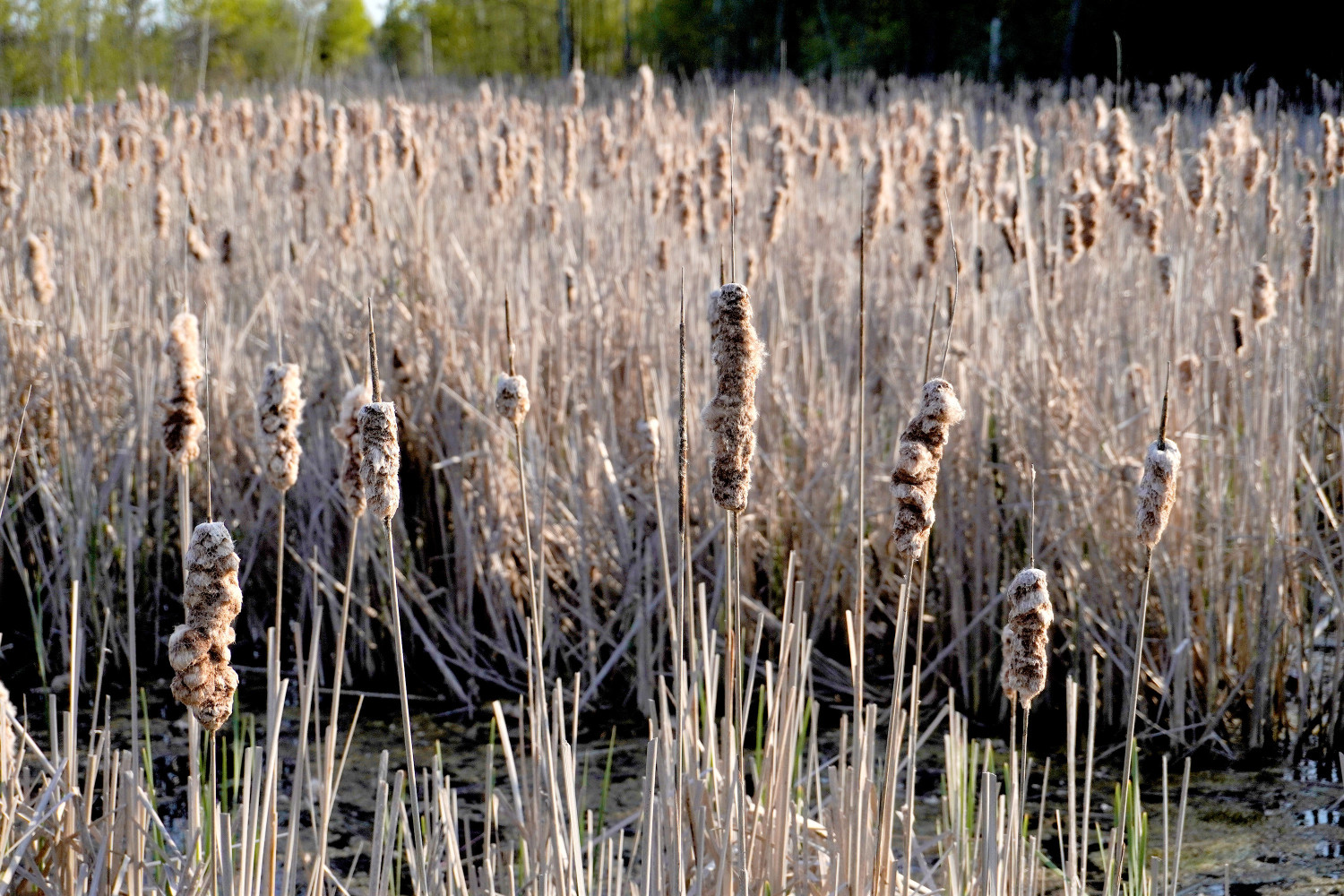
Invasive species are a top threat to biodiversity: how to spot and manage them in Peel
Walking through the Lorne Park neighbourhood, it is hard to picture anything but perfectly manicured lawns with bright gardens that surround the multimillion dollar homes in one of Mississauga’s wealthiest neighbourhoods. But wedged between two residential streets, invisible from the main road, lies Tecumseh Park.
From the outside, it appears like any other, a green retreat for those seeking a temporary disconnect from the teeming city. But as you explore further into the park, a variety of smaller ecosystems, each with their own hidden secrets, come alive.
Last weekend (Saturday May 13), the City of Mississauga held its first annual invasive species fair to educate the public on these threats to the natural features in their own community.
To the general public, the park appears vibrant. Though the closer one looks, the more clear the true health of the park becomes apparent. The woodlot has been decreasing in recent years due to a variety of factors including activity on footpaths, other physical encroachments, soil compaction and invasive species.
Part of the park has been blocked off for restoration which includes invasive species management, which began in 2019, and the planting of native tree and shrub species to regenerate the forested areas.
Tecumseh Park is only one example of habitats in distress. The presence of invasive species is increasing across the province. Auditor General Bonnie Lysyk determined in one of her audits last year the Ontario government is severely lacking in management of this issue.
The Credit Valley Conservation authority (CVC) defines an invasive species as a “non-native species that displace native species, dominate ecosystems and impact ecological integrity and ecosystem functions.” These species can outcompete native plants and animals dramatically altering ecosystem functions.
Currently there are 184 documented invasive species in the Credit Valley watershed, which encompasses Tecumseh Park. The CVC estimates that over 90 percent of vegetation communities within the watershed contain at least one invasive plant species. They are also currently monitoring 56 additional species that threaten to enter the watershed.
Conservation authorities play an important role in the management and eradication of invasive species, but as outlined by Lysysk, there needs to be support in place by various levels of government in order to make eradication and control possible.
“Credit Valley Conservation Authority’s invasive species strategy identifies 31 priority actions, but its staff informed us that it does not have the funding nor staffing resources to undertake a comprehensive approach to managing invasive species within the Credit River watershed,” she wrote in her audit.
Conservation authorities are responsible for invasive species that fall into four categories: vascular plants, fish, forest pests and non-vascular plants such as mosses and some algae. The CVC’s Invasive Species Strategy (ISS) notes that management is not practical for all invasive species within the watershed. Instead, the agency has developed a list of species which are within the scope of the ISS and which can be practically managed within the watershed.
Conservation authorities also provide extensive outreach and education programs. They recognize the community can play an important role in eradication and control, participating in the removal of invasive species on their own properties and planting native species to promote healthy, diverse ecosystems.
“A huge component of the work we do is the work with watershed residents to help them stop the spread of invasive species,” Kata Bavrlic, a senior analyst at CVC, said on an episode of The Pointer’s What’s the Point podcast. “So this includes programs like going and helping landowners with managing their own invasive species, educating the public on different actions they can also take.”
One of the most crucial first steps is learning how to recognize invasive species. Once you are able to recognize which species pose a threat to local biodiversity, we can begin to look at eradication and control measures.
Phragmites (common reed)
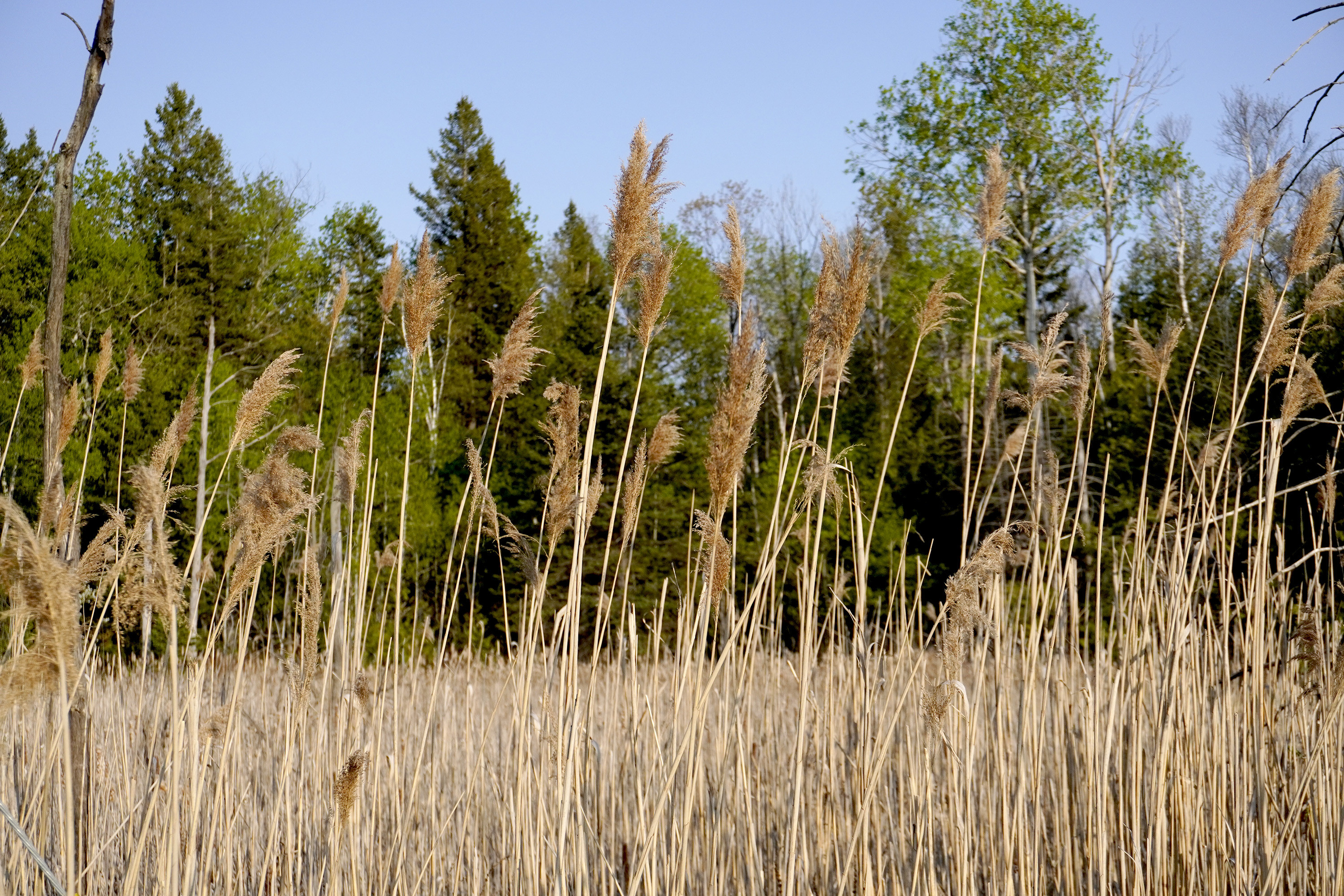
(Alexis Wright/The Pointer)
Phragmites are found virtually everywhere in Ontario, so much so that many people do not realize they are an invasive species. It is unknown how phragmites made their way to Canada from their native home in Eurasia, but since their introduction to North America, which was estimated to be in the 18th or 19th century, phragmites have travelled across the landscape, outcompeting native vegetation.
According to the Invasive Phragmites Control Centre, invasive phragmites have reached nearly every corner of southern Ontario — they were even brought over to Manitoulin Island by a group of people who, not realizing the species was invasive, thought it would be a nice addition to the ponds at their cottages.
Phragmites are an invasive perennial grass that can grow up to 5-metres high, found in wetlands, on the edge of other water bodies and alongside roads in ditches. They can spread rapidly and outcompete native plants for water and nutrients. Phragmites also release a toxin from their roots that makes it extremely difficult for other plants to grow nearby. Due to their expansive reach, phragmites control is undertaken by conservation authorities in collaboration with municipalities, the Ministry of Natural Resources and Forestry and the Ministry of Transportation.

The Invasive Phragmites Control Centre is responsible for removing phragmites and restoring wetland habitats across Ontario.
(Alexis Wright/The Pointer)
But phragmites pose a further risk than just outcompeting native vegetation. The tall grasses can pose road risks due to their height, provide unsuitable habitat for wildlife and are a fire hazard. They also grow very quickly contributing to a lower water level in the area than would exist with natural vegetation.
The CVC estimates conservation authorities and Ontario municipalities spend over $3 million annually on phragmite management. Earlier this year, the Ontario government announced a $1 million investment going to the Invasive Species Centre and the Nature Conservancy of Canada to help combat invasive species. Half of the money allocated would go towards phragmite control.
The two main methods of phragmites control include herbicide application and cutting down the stalks. Herbicide can be applied by licensed applicators who spray at the base of the stalks which eventually kills the plant.
The more common method of control is the complete removal of phragmites. The tall grasses can be cut and removed by hand. When the plants are cut in deep water they can no longer receive oxygen, making it possible for 100 percent mortality of the phragmites in the area. Cutting below the water also makes it significantly more difficult for the species to reestablish itself. Once the phragmites are removed, monitoring and long term management can take place to ensure the species does not take over the area again.
Garlic mustard
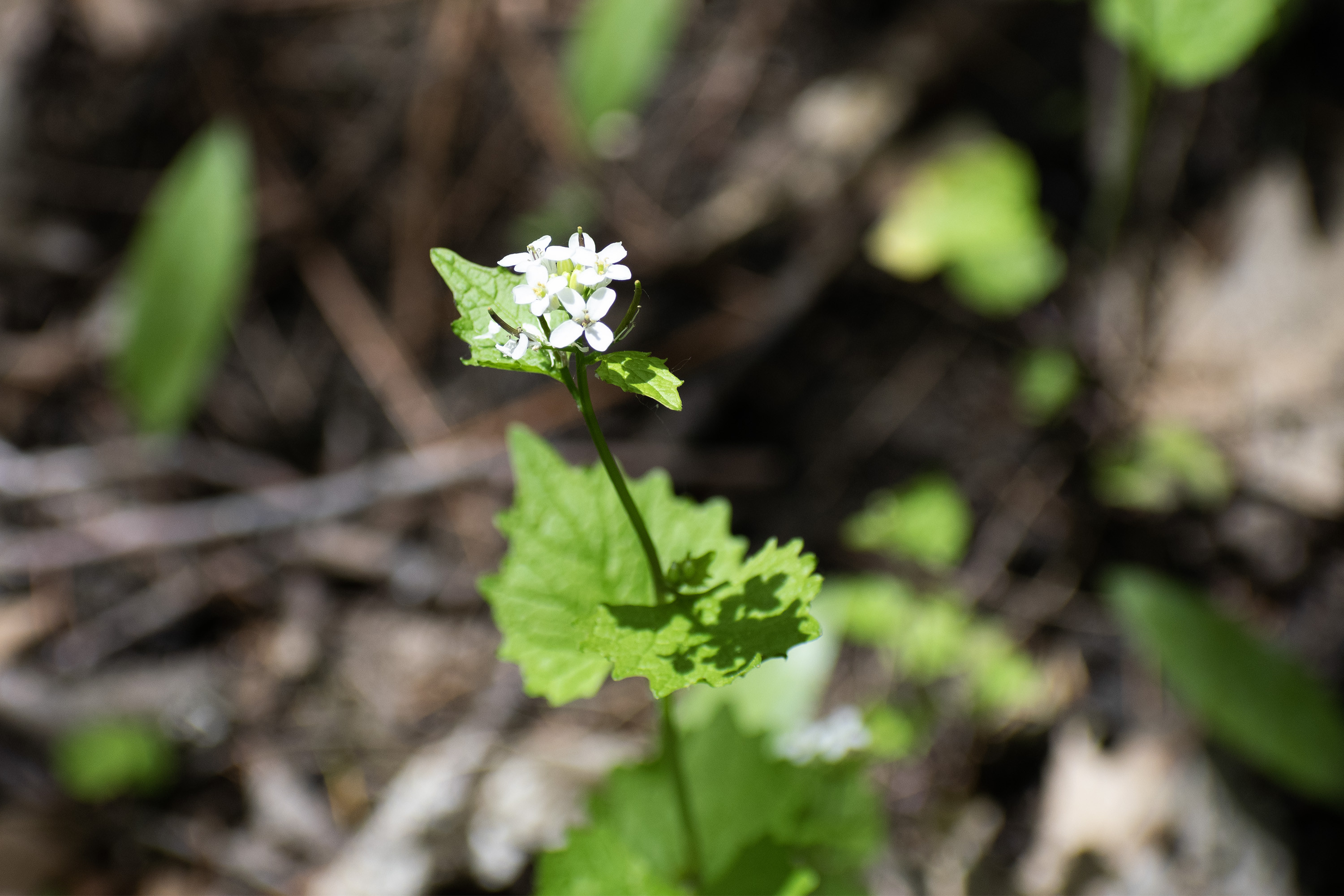
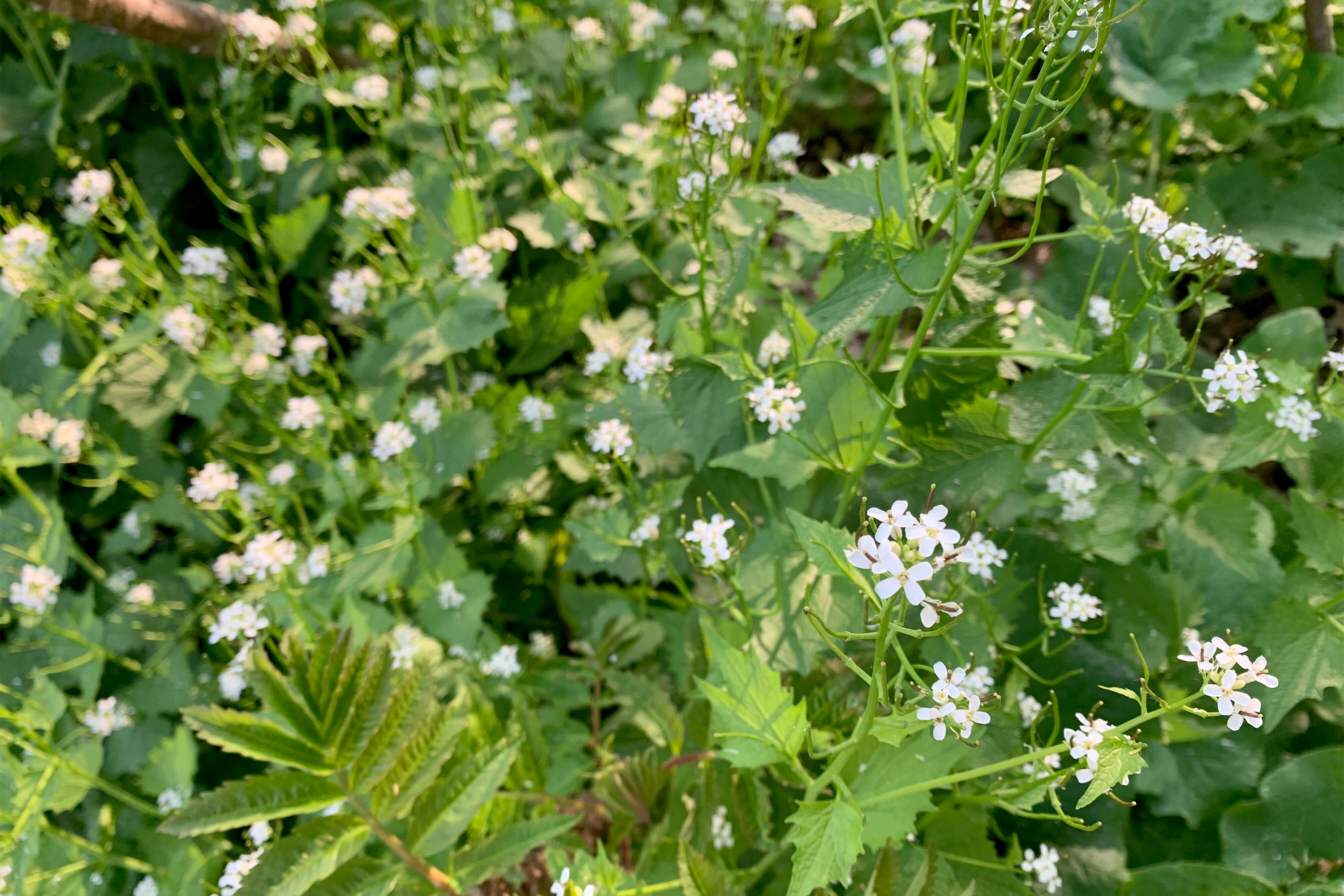
(Alexis Wright/The Pointer)
Garlic mustard is an edible perennial herb native to Europe that was introduced to North America in the 1800s for culinary purposes. But once the herb was planted, it quickly spread, becoming one of Ontario’s most aggressive invasive species. Seeds generally fall very closely to the parent plant and it is unlikely for them to spread by air or water. The most common way the plant travels to new areas is by humans or pets. But despite this, the plant has the potential to dominate ecosystems. According to the Invasive Species Centre, garlic mustard can enter, establish itself and become the dominant plant in a forest understory within just five to seven years.
Garlic mustard is a low growing plant, with heights up to one metre. It is identifiable by its triangular coarse leaves, white flowers with four petals (which bloom in early May) and seed pods ranging from 2.5 to 6 centimetres in length. The plant’s appearance has people often mistaking it for a wild flower, but the innocent looking herb has the potential to destroy local ecosystems.
The roots of the garlic mustard plant produce chemicals that have been shown to disrupt and prevent the growth of other plants and grasses. But the herb also has the potential to harm species much larger in size. The chemicals produced also affect the regeneration of beneficial fungi in the soil that help trees uptake water from their roots. These fungi are extremely crucial for young seedlings of native tree species like maples and oaks. When these seedlings are displaced, it has the potential to impact the ecosystem for generations.
There are a few different methods for controlling garlic mustard depending on the plant’s life stage. For small populations, plants can be removed from pulling out the entire plant including the root. Specifically, attention must be paid when pulling plants to make sure the entire S-shaped root is removed from the soil. For larger populations, complete removable is not always viable. Cutting the plants at the base of the stem or clipping flower heads can help halt seed production, limiting the plant’s ability to spread. This needs to be done multiple times per season as the plant will regenerate. The Invasive Species Centre stresses the importance of not composting invasive plants that are pulled as it will enable the seeds to move into unchartered territory. Disposal should be done in garbage or yard waste bags.
Lymantria dispar dispar (spongey moth)
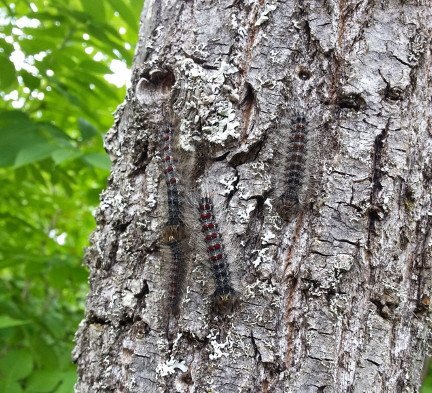
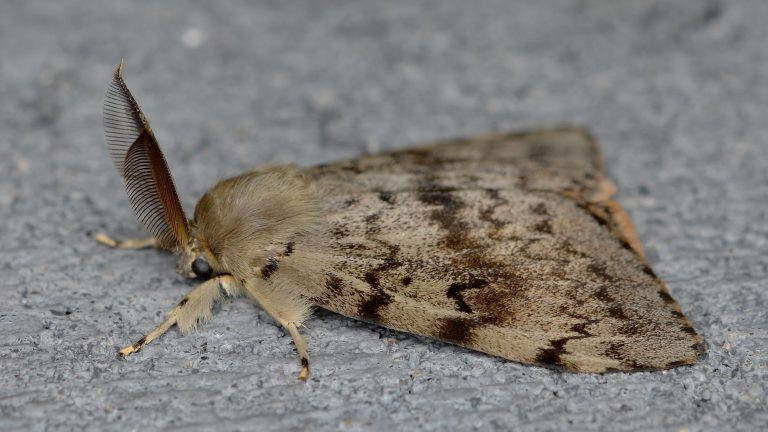
(Invasive Species Centre)
The spongy moth is a species of insect native to Europe that made its way to North America in the late 1800s with an entomologist who was doing experiments. Some of the moths escaped and from then on began to populate the eastern areas of the United States and Canada. The insect has the ability to spread quickly as each female moth can lay between 500-1,000 eggs each breeding season. Outbreaks of the spongy moth tend to occur in seven to 10 year cycles with each cycle lasting two to three years. However, climate change and other environmental influences can impact these cycles as warmer weather creates more desirable breeding habits.
In years of outbreaks, the caterpillars are often easy to identify by their unique markings. The spongy moth caterpillar has a beige head with black dots and a black body. The body is marked by a double row of five blue dots below the head, followed by a double row of six red dots on the lower back. From late august to mid april, egg masses can also be found on trees which appear as beige coloured fuzz on the trunk of trees and in other semi hidden areas.
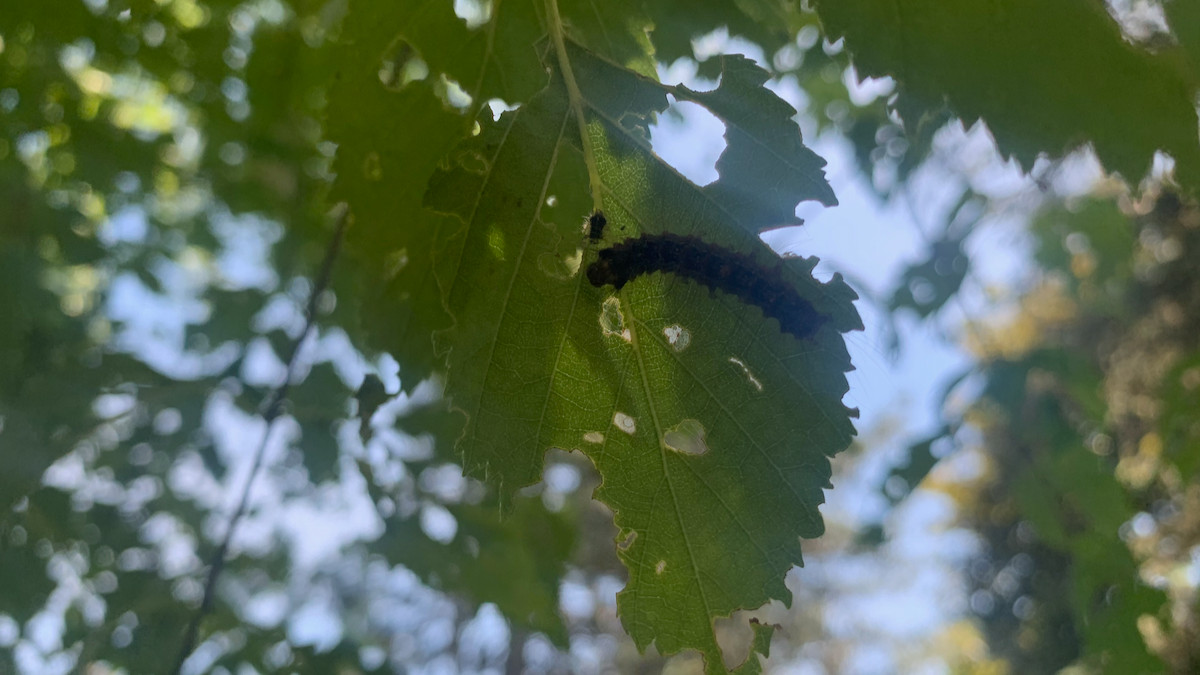
Spongy moth destruction of a birch tree in 2021.
(Rachel Morgan/The Pointer)
The spongy moth has the ability to cause massive casualties of hardwood trees. At the caterpillar stage, the spongy moth feeds on the foliage of a variety of tree species with some of the most common being birch, oak, apple and willow. In 2020, at the beginning of one of the most devastating outbreaks in Ontario’s history, the spongy moth caterpillars caused almost 600,000 hectares of defoliation across the province. Generally trees can withstand the destruction for one year, but the impact becomes more deadly with impacts in consecutive years.
Control measures for the spongy moth differ depending on the life stage of the insect. Generally control is focussed on the egg, caterpillar or pupae stage as the actual moths are short lived. In 2022, the City of Mississauga conducted an aerial spray program throughout the spring and summer months that was successful in suppressing the spongy moth population. However, the problem with aerial spray programs is that the biological pesticides used also affect the mortality of other caterpillar species.
Individual control measures can be taken at various life stages. When fuzzy egg masses are found on the trunks of trees they can be scraped off by hand. Similarly, pupae or cocoons can be hand picked off of trees and other surfaces. During the caterpillar stage, it is recommended that residents wrap the trunks of their trees in either burlap or duct tape. This will trap the caterpillars when they make their way up the trees to feed on the leaves and make them easier to remove.
Emerald ash borer
(Alexis Wright/The Pointer)
The emerald ash borer is a species of wood boring beetle native to Asia that was first detected in Ontario and the US in 2022, though it is believed to have been inhabiting North America since the 1990s. Adult beetles feed on foliage, decemating ash tree populations. The beetles have been known to kill 99 percent of the ash trees in their path making them a huge concern for municipalities and conservation authorities.
The emerald ash borer is a hardy species that can withstand almost any climatic condition thrown at it. It was previously believed that larvae could not survive below -35 degrees celsius but new research shows the species can actually survive temperatures as low as -50.
Adult beetles feed on the foliage of ash trees and lay their eggs in crevices within the tree bark. Larvae chew through the eggs and the tree bark to hatch and bore into the wood where they grow over the winter. When populations become large enough, the larvae feeding on the bark can lead to eventual tree death.
Adult beetles are bright green and metallic approximately 0.75 to 1.5 centrimetres in length. The larvae are a creamy white colour but are often not seen as they are borne in the trees. One can detect an infestation in an ash tree by identifying vertical cracks in the tree bark, D-shaped exit holes, woodpecker feeding holes and yellowing foliage.
The emerald ash borer has become so widespread that eradication is no longer the goal. Rather municipalities and conservation authorities work together to focus on methods of controlling the population and minimizing the damage caused.
In the 2023 budget, the City of Mississauga allocated over $4 million for an emerald ash borer management program, the most money allocated for any forestry initiative across the City. There are a few methods of mechanical, chemical and biological control used across Ontario to manage the population of these beetles. Mechanical control includes cutting down and burning infested trees to slow the spread of populations in areas with minor infestations. Residents of Ontario are also cautioned against transporting firewood between municipalities in case of beetle habitats within the wood.
Canada also has four registered insecticides that can be injected into the base of infected ash trees. This control method works best if it is done before or immediately after a tree is infested. Reapplication may be necessary and it can take several years for the tree to make a full recovery. Four species of wasp have also been regulated in Canada as a form of biological control against the emerald ash borer. These wasps do not sting humans and their effects on native species are closely monitored.
Hemlock woolly adelgid
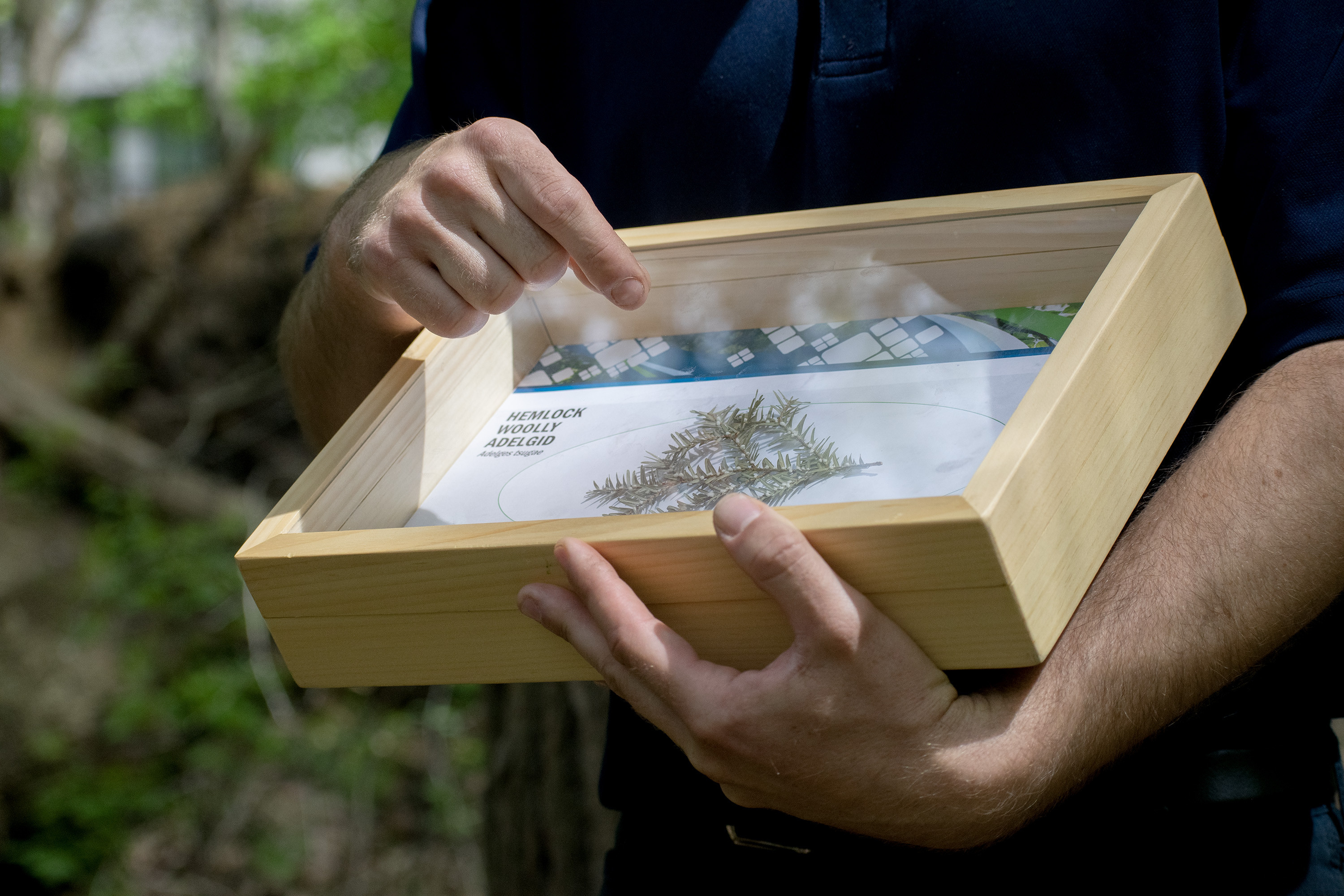
(Alexis Wright/The Pointer)
The hemlock woolly adelgid (HWA) is an aphid-like insect that targets hemlock species. It is believed the insect made its way to North America from Japan, carried over in nursery stock, and was first introduced to America in the 1950s. HWA has been established along the eastern states of the US and serves as a threat to the eastern hemlock tree which is present across the eastern provinces of Canada. Small populations of HWA have been found in Nova Scotia and in Ontario. While HWA has yet to be found in Mississauga, it is on high alert for the CVC as the insect has been most recently found in Oakville.
HWA infestation is certain death for hemlock trees feeding on nutrient and water storage cells at the base of the needles. The loss of hemlock trees would lead to catastrophic consequences for the rest of the forest ecosystem. Hemlocks are a popular species for a variety of birds to feed on and nest in. They also play an important role in regulating water temperature making it habitable for cold water species such as the brook trout. The loss of hemlock trees would have a significant impact on energy inputs, nitrogen cycles and the microclimate environment.
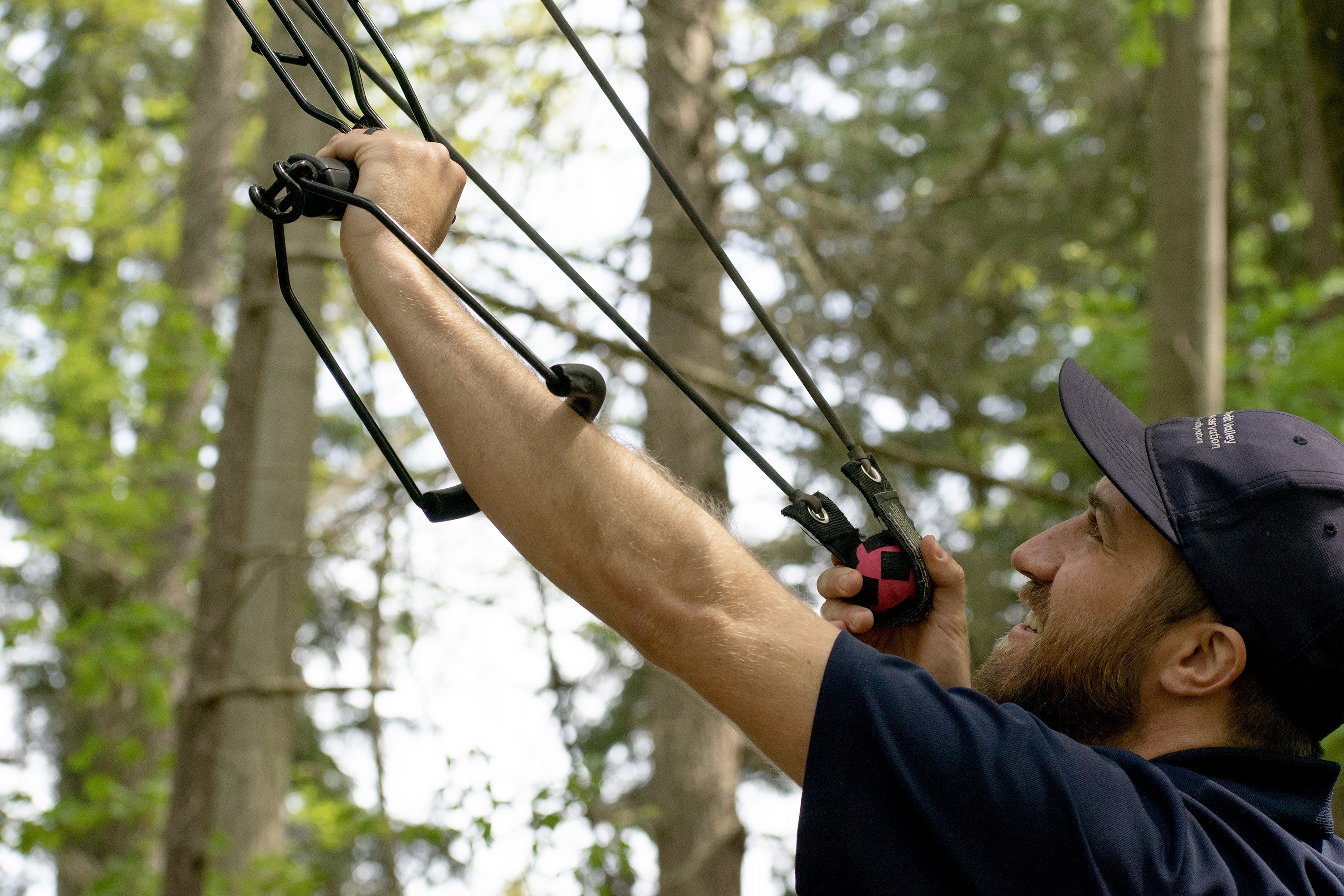
The only reasonable way to test for HWA is with a slingshot and a ball covered in velcro to see if there are any that drop.
(Alexis Wright/The Pointer)
Identifying HWA in hemlock trees is very difficult because they are incredibly small in size. The insect is often also transported to new locations on birds, leaving it within the highest reaches of the trees. Conservation authorities as well as municipalities take part in monitoring for HWA using a slingshot with a small ball covered in velcro. The ball is shot up into the tops of the trees. If HWA is present, it will stick to the velcro. This is done periodically to check for HWA in areas particularly at high risk.
The threat of invasive species continues to grow with the continual movement of species and goods across the globe and with other climatic factors such as climate change making more habitats suitable for a variety of species.
As is the case with the emerald ash borer, complete eradication of species is not always possible or necessary, but careful monitoring of species can keep biodiverse habitats healthy for a wide range of native species. One of the simplest ways individuals can act to help protect biodiversity in their communities is by planting native species within their landscapes, with the hopes of outcompeting invasive species.
“We're also really actively involved in restoration projects throughout the watershed to enhance the resilience of natural heritage features, which also prevents their further establishment through the watersheds,” Bavrlic said. “So by increasing diversity and the canopy and the understory, the more native plant species we put in the ground and protect then they're more likely to prevent the establishment of invasive species.”
Email: [email protected]
Twitter: @rachelnadia_
At a time when vital public information is needed by everyone, The Pointer has taken down our paywall on all stories relating to the pandemic and those of public interest to ensure every resident of Brampton and Mississauga has access to the facts. For those who are able, we encourage you to consider a subscription. This will help us report on important public interest issues the community needs to know about now more than ever. You can register for a 30-day free trial HERE. Thereafter, The Pointer will charge $10 a month and you can cancel any time right on the website. Thank you
Submit a correction about this story



